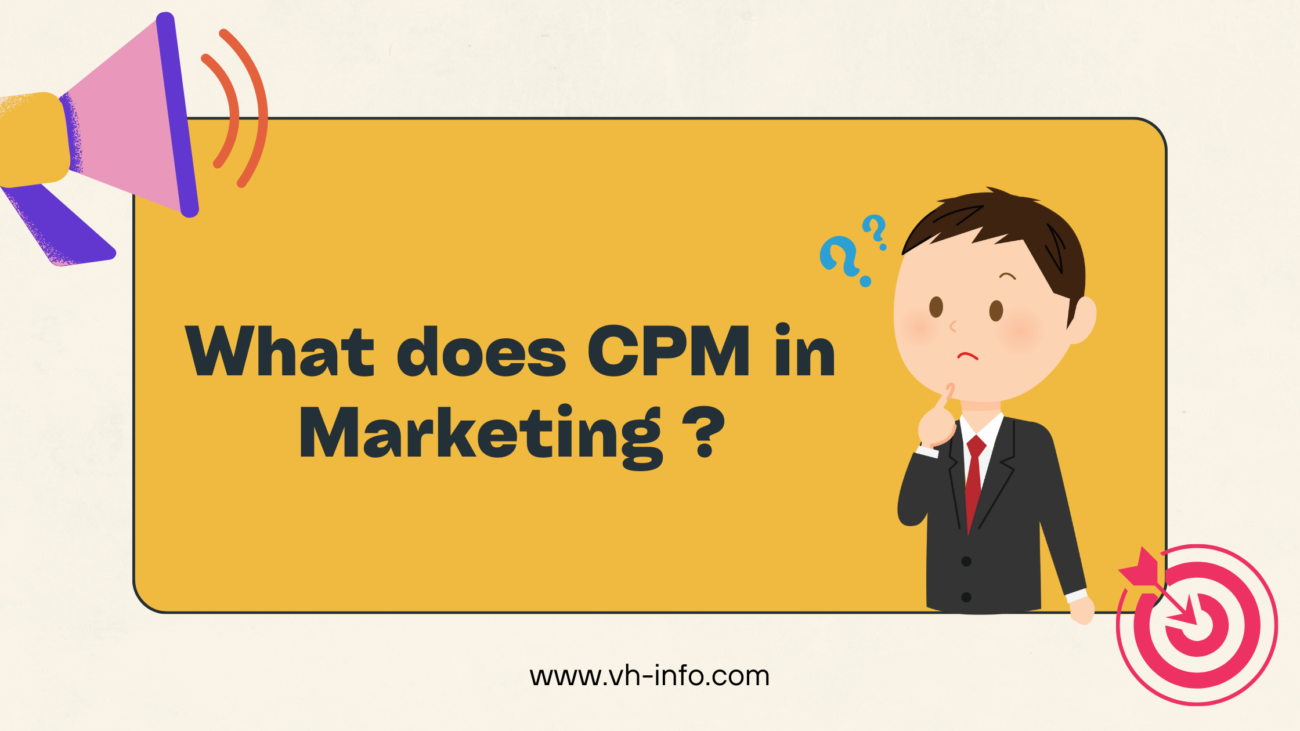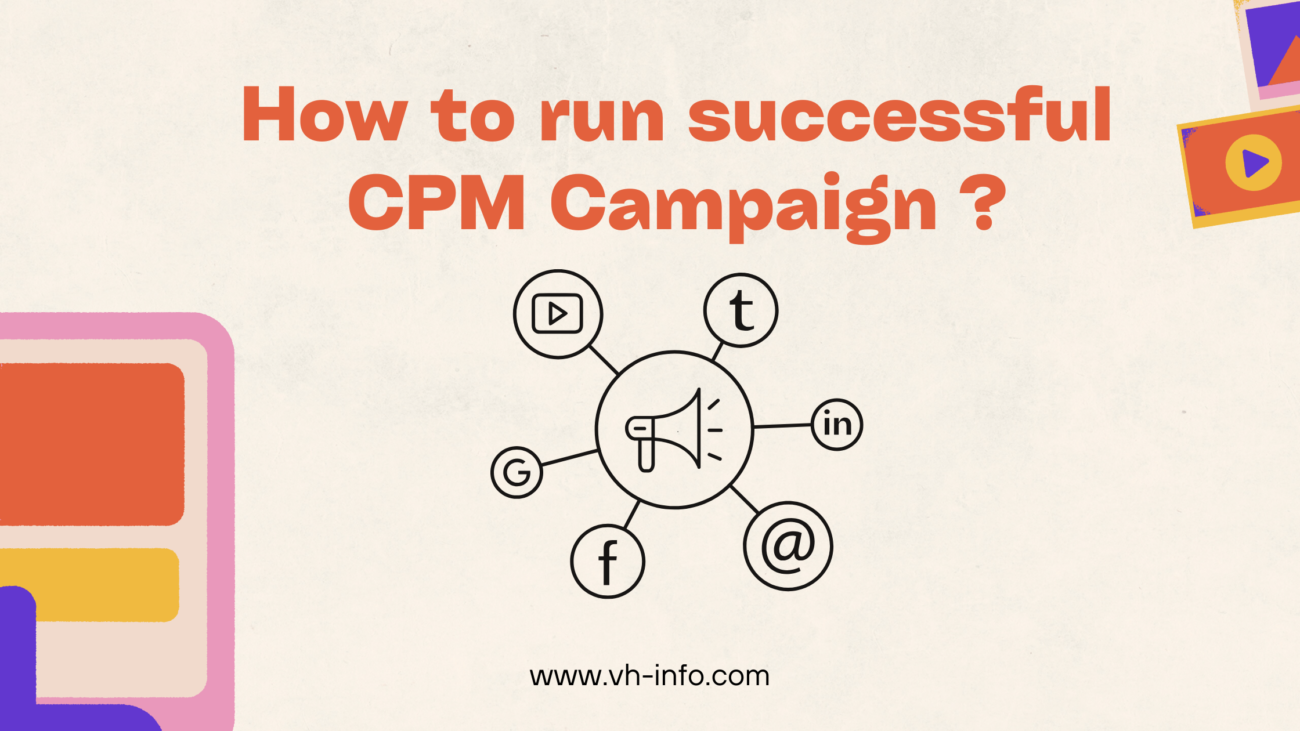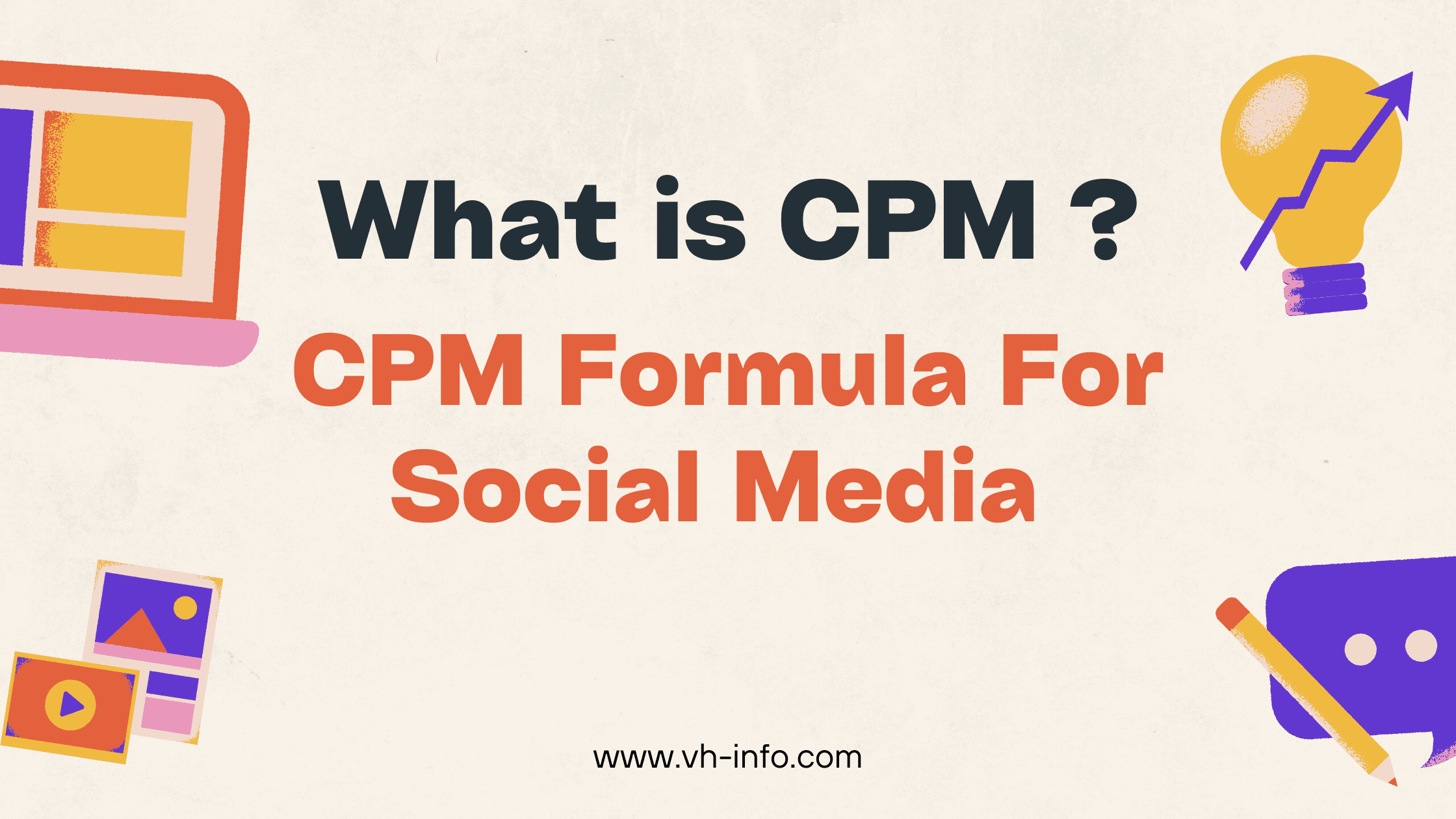Are you struggling to understand the different pricing models in digital marketing?
One term that you’ve probably come across is CPM, which stands for Cost Per Mille or Cost Per Thousand. It’s a pricing model used by advertisers to pay for every thousand impressions their ad receives.
In this comprehensive guide from VH-Info, we’ll take a deep dive into what CPM is and how it relates to digital marketing. We’ll also explore its benefits and drawbacks, and help you determine if it’s the right advertising method for your business.
Additionally, we’ll provide you with some tips on running a successful CPM campaign, and answer some frequently asked questions about ad impressions, traffic seasonality, and more. So let’s dive in!
What does CPM mean in marketing?

In digital marketing, CPM stands for “cost per thousand impressions” and refers to what an advertiser pays for 1,000 impressions of an advertisement on a web page. An impression means that the ad loaded and was viewable on a page, which is different from an actual page view. This distinction is important in CPM marketing because advertisers are charged when an ad is displayed, not necessarily when someone actively views the page it is on.
So with CPM pricing models in digital marketing & social media, advertisers pay for the exposure and prominence of their ads based on impressions, rather than on user engagement or conversions. The CPM metric allows digital marketers to assess the cost-effectiveness of ad placements and increase brand visibility through a digital marketing campaign across different websites and platforms, ultimately leading to a higher total ad spend.
Impressions vs. page views
Page views and impressions are often used interchangeably, but they’re not quite the same. A page view happens when a web page loads and a user clicks on another page. On the other hand, an impression means that an element like an ad loaded for the user to see. Impressions can vary depending on the advertising platform and settings.
For instance, each visit to a web page increases the page view count, but the same ad may not appear every time, so impressions might not match page views. Both metrics are valuable for businesses and marketers, and they’re crucial for publishers aiming to boost website traffic.
The importance of click-through rate (CTR)
Click-through rate (CTR) is a crucial metric in online advertising because it shows how many people actually click on an ad after seeing it. You calculate it by dividing the number of clicks by the number of times the ad is shown (impressions) and then multiplying by 100.
This rate helps marketers evaluate how well an ad is doing in terms of user experience. It can provide insights into various aspects of the campaign, like whether the ad copy or title is effective. A low CTR can indicate issues with targeting or ad placement, while a high CTR suggests that a particular keyword or ad is performing well and could be optimized further, making CTR an essential tool for making informed decisions in digital marketing.
How Does CPM Relate to Digital Marketing?

CPM (cost per thousand impressions) is a pivotal pricing model in digital marketing because online ads are often sold on a CPM rate basis. With the pay-per-impression model, advertisers pay only when their ad is displayed, making it well-suited for digital marketing channels like display ads, social media ads, and banner ads where ad visibility matters.
CPM provides digital marketers with a standardized way to assess the value of inventory across publishers and make decisions about the best platform for their campaigns. Additionally, CPM allows marketers to accurately calculate the total cost of their campaigns, making it an essential tool in digital marketing.
The CPM cost metric allows marketers to calculate the relative cost efficiency of different ad placements and make optimizations to get the most exposure for their spending. Unlike CPC or CPA pricing models, CPM lets advertisers focus solely on getting ad impressions, making it an important factor in the cost of impressions, rather than immediate clicks or conversions. This makes it an attractive option for building brand awareness through visibility in digital marketing initiatives.
An alternative to CPM
An alternative to CPM is “Viewable CPM (vCPM)“, which measures how often an ad is actually seen by users rather than just loaded by a browser. It calculates the cost for a thousand viewable impressions, making it preferable for direct-to-consumer (D2C) brands because they only pay when users genuinely see their ad through ad viewability.
According to industry standards, an ad is “viewable” when a user sees over half of it for at least one second, and the same rule applies to video ads on a vCPM basis. Essentially, vCPM ensures advertisers get more value since, with traditional CPM, most ad impressions often go unnoticed, resulting in advertisers paying almost three times more to reach the same audience.
CPM vs other types of paid search
CPM advertising isn’t the only way to pay for online ads. There are different methods that might be a better fit for your goals. Some of these methods can even work together with CPM advertising. It’s a smart move to learn about these common pricing models and paid search options so you can choose the right one for your needs wisely.
Pay-per-click (PPC)
Pay-per-click (PPC), also known as cost-per-click (CPC), means you pay for every click on your ad. It’s a way to get your ad in front of the right audience, and platforms want your ads to get clicked to show them more prominently.
However, this can make advertising more expensive, especially when bidding for ad space. Marketers need to ensure that the benefits of a click are worth the cost. You often see PPC ads on search engine result pages (SERPs), so knowing how search engines operate is handy for PPC advertising.
Cost per action (CPA)
Cost per action (CPA) is a way of paying for ads based on specific actions people take, like registering for an event or making a purchase. It’s useful for businesses with precise goals. You can also think of it as cost per acquisition when you pay for a particular action. CPA lets you choose what actions you want to pay for, but it might not be the best choice to start with. Sometimes, it’s better to try other pricing methods first to figure out which actions are worth paying for in your advertising campaign.
How do you calculate CPM?

CPM (cost per mille) or cost per thousand impressions is calculated by dividing the cost of an advertising campaign by the number of impressions delivered and multiplying that by 1,000.
For example, if an ad campaign costs $1,000 and delivers 400,000 impressions, the CPM would be calculated as:
Cost of campaign: $1,000
Impressions delivered: 400,000
CPM = (Cost / Impressions) x 1,000
Plugging in the numbers:
CPM = ($1,000 / 400,000) x 1,000 = $2.50
So the CPM for this example campaign is $2.50. This means the advertiser paid $2.50 per 1,000 impressions. Calculating CPM allows advertisers to evaluate the cost-effectiveness of a campaign compared to other channels on an apples-to-apples basis using the common metric of cost per thousand impressions.
Benefits of using CPM
- Budget-friendly – CPM is typically one of the lowest-cost ad pricing models. You only pay for the impressions delivered.
- Increases brand awareness and reach – Your ads are seen by a wide audience which builds recognition.
- Facilitates lead generation – Can help identify and build a database of potential leads through targeting.
- Provides metrics and data – The impressions give insights to refine future ad campaigns.
Drawbacks of using CPM
- Unqualified traffic – You don’t know the context or quality of the impressions. May reach audiences with no interest.
- Impressions don’t guarantee actions – Awareness doesn’t always translate into clicks or conversions.
- Risk of ad fraud – Bots can artificially inflate impressions leading advertisers to overpay.
So CPM can be cost-effective but the quality of exposure matters. It’s best used to complement other models like CPC and CPA to drive actions.
Is CPM advertising right for your business?
CPM advertising can be a good fit for businesses looking to increase brand recognition and reach, especially those with limited social media marketing budgets and targeting a niche audience. The low cost and ability to get your ads seen by a wide audience make it appealing. However, it may not be the best model if you are focused on driving direct response and optimizations based on clear performance data. CPM provides mass exposure but the quality of impressions can be uneven.
For early-stage businesses trying to establish themselves and test messaging, CPM offers an affordable way to experiment build recognition, and manage ad spend. More mature businesses seeking measurable ROI will likely need to pair CPM with pricing models like CPC that focus on engagement.
Overall, CPM is best suited for awareness goals rather than conversions, making it a good option for businesses looking to run successfully. Evaluate whether impressions or clicks/actions align better with your marketing objectives to determine if CPM meets your needs.
Should you display ads on your website?
When deciding whether to put ads on your website, there’s no one-size-fits-all answer. It depends on your business and goals. Ads can make you money, but they can also divert attention from your site’s main content. If you choose to display ads, one way to earn is through the CPM model, where advertisers pay for every 1,000 ad views. This can bring in revenue if your site has lots of traffic and ad space to offer. So, it’s a decision that depends on your specific situation and what you aim to achieve with your website.
What Is a Good CPM for Display Ads?
Whether a CPM for display ads is good or not really depends on what your business wants to achieve. Sometimes, high CPMs might mean you’re not using all your ad opportunities, while low CPMs could be because your ads are reaching the wrong people. However, a high CPM can also be a positive indicator, but it needs to be contrasted with other data to truly understand if a rate is cost-effective. It’s all about matching your average CPM to your specific goals and needs.
To get a good CPM in your marketing campaign, make sure that you test multiple ad copies and continuously refine your target audience. This will ensure better CPM strategies* which will help you get a good CPM rate over time in your digital marketing strategies.
*CPM strategies are best suited for brand awareness campaigns aimed at reaching a broader audience, rather than targeting niche markets. Ultimately, the success of CPM strategies depends on how well they are implemented and optimized to achieve specific marketing goals and reduce advertising fraud on ads that don’t load properly.
How to run a successful CPM campaign ?

Even when different metrics are targeted for optimization, most Facebook campaigns still operate on a CPM pricing structure. Other advertising networks such as Google Display Network (GDN) also use the CPM pricing model.
To meet your cost-per-thousand (CPM) advertising campaign goals, you need to plan and prepare. It’s not just about setting it up and forgetting it. Most marketers understand that any advertising campaign needs some upfront work. To get you going, here are some steps to follow for success with CPM advertising.
Determine your budget and risk tolerance
Before you start, decide how much money you’ll spend on your CPM campaign and make sure to stick to that budget. Also, think about how much risk you can handle. Advertising campaigns are like investments, and all investments have some risk. Can you afford to lose the money you’re planning to use for this project? If you’re just trying out CPM and not ready to spend a lot, begin with a smaller budget to see how it goes and to achieve your campaign goals.
Carefully time your campaign
A thousand views of your ad happen fast. So, think about when it’s best to show your CPM ads instead of displaying them right away. The time of year can impact who sees your ad, as well as the ad format. Also, the lower cost of CPM ads can change, and it might be different in various seasons or during special occasions or big events in certain industries.
Note: Carefully timing your campaign is crucial, and the first month of the quarter is a good time to do any testing on your site.
Choose an ad platform
Picking the right ad platform is a big decision. There are many advertising platforms to choose from, some specialized just for ads and others that offer marketing services too. Google Display Network is well-known for display ads, so starting with Google Ads and utilizing Google AdSense is a good idea. But if you have a specific message for a certain audience, look for platforms that cater to that audience.
For example, if you want to advertise on social media, check if they have CPM ad options. Most social media sites do, so it’s often better to use them for those platforms.
Create the ad
When making your ad, be very careful with every part of it. If you’re not sure, look up the best ways to create the kind of ad you want. What’s good for one type of ad might not be good for another. Remember this while making your ad. Also, know that the advertising platform you use can limit some of the things you can do when creating your ad.
Track performance
After your ad is shown to people, watch how well it does by using data tracking tools. CPM ads are good for collecting data fast. This data helps you understand what to do better in your next CPM ads.
FAQ: Frequently Asked Questions
What Is an Ad Impression ?
An ad impression means that an ad has loaded and had a chance to be seen on a website, social media, or other digital places. It’s different from a “view“ because someone might not notice the ad even if it is loaded. Impressions are crucial in digital advertising to count how many times an ad is shown. When you buy ads based on CPM (cost per thousand impressions), it tells you how much you owe. It helps advertisers see how far their ads can reach, but it doesn’t guarantee that people actually look at them.
How Do You Choose the Right Online Advertising Pricing Model?
Selecting the best online advertising pricing model really comes down to what you want to achieve, who you’re trying to reach, and your industry. CPM is safer for those showing ads but might not give advertisers the results they want. On the other hand, CPA puts more risk on the ones displaying the ads but can cost more for advertisers. It’s all about balancing your goals and the audience you’re targeting.
How Does Traffic Seasonality Influence CPM?
Traffic seasonality can impact the number of people visiting a website and how many ad views it gets. For example, a dating site might see more visitors around Valentine’s Day, which can drive up the cost of ad views (CPMs) during that time due to increased competition for ad space.
How Do You Forecast Impressions?
There are several common methods for forecasting impressions such as using historical campaign data, impression share metrics, building forecast models, leveraging ad platform tools, consulting industry benchmarks, and estimating reach based on target audience size. The best approach depends on your specific goals, budget, audience, creative assets and other factors. A combination of historical data, platform tools, benchmarks and reach estimates generally provides the most accurate impression forecast, which should then be continuously optimized based on actual performance.
Conclusion
In recent years, online advertising has grown a lot because there are more than 5 billion people using the internet, and over 2.14 billion people shop online. But because the economy is sometimes uncertain, people who make ads need to always learn about the latest advertising trends to do better than their competitors.
In conclusion, understanding CPM in marketing is essential for maximizing your advertising efforts. It allows you to measure the cost-effectiveness of your campaigns and make informed decisions about your budget allocation. By calculating CPM, you can determine the efficiency of your ads and compare them to other types of paid search strategies such as PPC and CPA.
However, it’s important to consider the drawbacks of using CPM, such as the lack of guaranteed engagement and potential ad fraud. Assess whether CPM advertising aligns with your business goals and audience before implementing it. If you decide to run a CPM campaign, be sure to carefully plan and track performance to optimize your strategy.



